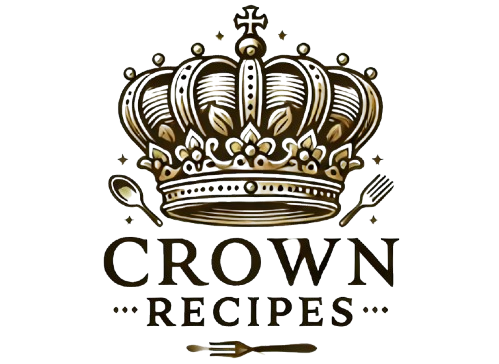Introduction
Few desserts offer the warmth and comfort of a homemade crumble. With its crisp, buttery topping over a soft, fruity base, this treat is simple yet irresistible. Whether you prefer a classic apple crumble or a summery berry blend, this easy dessert is perfect for any occasion.
In this guide, we’ll cover everything you need to know to make the best crumble recipe, from choosing the right fruits and perfecting the crumble topping to pro baking tips that ensure a crispy, golden finish. Plus, we’ll explore vegan and gluten-free crumble variations so that everyone can enjoy this classic dessert.
Ready to bake? Let’s dive in!
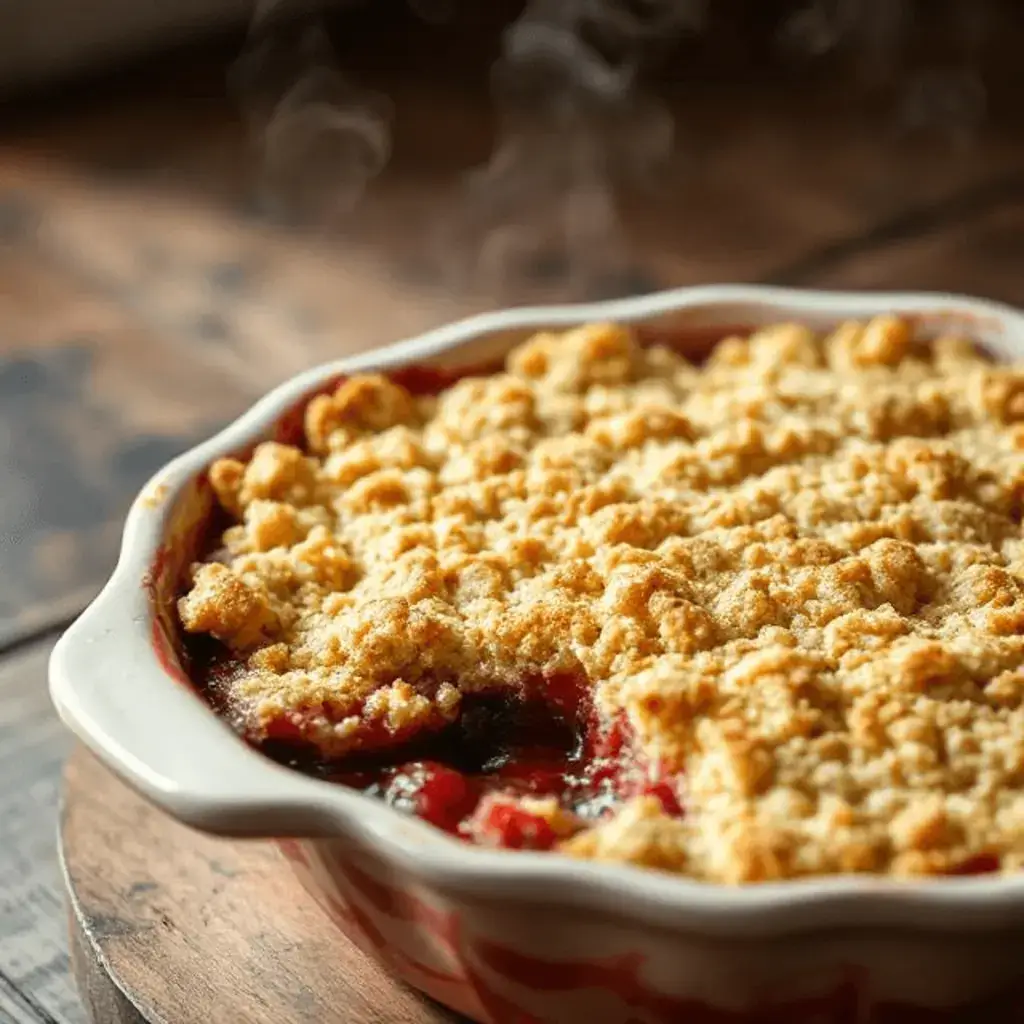
What is a Crumble? Understanding This Classic Dessert
Crumble is one of the easiest and most comforting desserts to make. With its warm, baked fruit filling and buttery, crumbly topping, it’s the perfect balance of sweet and crunchy. Whether you’re making a classic apple crumble or experimenting with berries, peaches, or rhubarb, this dessert is always a crowd-pleaser.
If you’ve ever wondered what makes a crumble different from similar baked fruit desserts like cobblers or crisps, this section will clear up any confusion.
Crumble vs. Cobbler vs. Crisp: What’s the Difference?
Many people use these dessert names interchangeably, but each one has unique characteristics:
1. Crumble
- A crumble consists of a sweet, fruit-based filling topped with a crumbly mixture made from flour, butter, and sugar.
- The texture is soft and juicy underneath with a crispy, golden topping.
- Crumbles can include extra ingredients like oats, nuts, or spices, but they are typically simpler than crisps.
2. Cobbler
- A cobbler features a biscuit-like topping instead of a crumbly one.
- The dough is either dropped in spoonfuls over the fruit (giving it a “cobbled” look) or spread across the top like a crust.
- It has a soft, cake-like texture rather than a crispy one.
3. Crisp
- A crisp is similar to a crumble but always contains oats in the topping.
- The oats create a crunchier texture than a traditional crumble.
- Some crisps also include nuts, seeds, or brown sugar for extra flavor.
So, if you’re looking for a dessert with a soft, juicy fruit base and a crispy, buttery topping, a crumble is your best choice!
Why Are Crumbles So Popular?
Crumbles have been a staple dessert for generations, and for good reason! Here’s why they’re loved by home bakers and dessert lovers alike:





Best Fruits to Use in a Crumble
One of the best things about a homemade crumble is that you can make it with a variety of fresh or frozen fruits. The key is choosing fruits that bake well and develop a soft, juicy texture while balancing sweetness and acidity.
1. Classic Crumble Fruits
These are the most popular fruits used in crumbles because they bake well and offer natural sweetness:
- Apples – The go-to fruit for a traditional apple crumble recipe. Granny Smith, Honeycrisp, or Braeburn apples work best. learn more about apple varieties here.
- Pears – Sweet, juicy, and perfect for a fall-inspired crumble.
- Peaches – Add a juicy, summery twist to your crumble.
- Berries – Blueberries, raspberries, strawberries, and blackberries create a vibrant, tart-sweet crumble.
2. Tart Fruits for a Balanced Flavor
If you love a tangy contrast to the sweet crumble topping, these fruits work perfectly:
- Rhubarb – Often paired with strawberries for a strawberry rhubarb crumble, rhubarb adds a sharp, tangy flavor.
- Blackberries & Cranberries – Their natural tartness balances the sweetness of the topping.
- Plums & Cherries – Juicy and slightly tart, they add depth to a crumble.
3. Unique and Exotic Fruits for a Twist
If you want to experiment beyond the classics, try these:
- Mango – Adds tropical sweetness and pairs well with coconut.
- Pineapple – Creates a sweet and tangy crumble with a tropical feel.
- Figs & Persimmons – Great for fall and winter crumbles.
4. Can You Use Frozen Fruit in a Crumble?
Yes! Frozen fruit works just as well as fresh fruit in crumbles. Just follow these tips:


Final Thoughts on Crumbles
Crumbles are one of the easiest desserts to make and offer endless variations. Whether you stick with a classic apple crumble, try a berry mix, or experiment with tropical flavors, this dessert is always a winner.
In the next section, we’ll dive into the essential ingredients you need for the perfect crumble—from choosing the right flour, butter, and sugar to adding extra crunch with oats and nuts.
Stay tuned!
Essential Ingredients for a Perfect Crumble
A great crumble relies on simple, high-quality ingredients that come together to create a buttery, crispy topping and a juicy, flavorful filling. Whether you’re making a classic apple crumble or a berry crumble, selecting the right ingredients is key to achieving the perfect texture and taste.
In this section, we’ll break down the essential flours, sweeteners, fats, and extras that go into making the best homemade crumble.
1. Choosing the Right Flour and Oats for Crumble Topping
Flour forms the base of the crumble topping, helping create a crumbly, slightly crunchy texture. The type of flour you use can impact the final result.
Best Flours for Crumble:




Oats: The Secret to a Crunchy Crumble
Not all crumbles include oats, but adding them can enhance texture and flavor.
- Rolled Oats: The best choice for a chewy, golden topping.
- Quick Oats: Work in a pinch but create a softer crumble.
- Steel-Cut Oats: Not recommended, as they stay too hard after baking.

2. Butter vs. Margarine: What Works Best?
A rich and crumbly topping depends on the fat you use. The choice between butter, margarine, or dairy-free alternatives will affect the flavor and texture of your crumble.
Best Fats for a Crumble Topping:





3. Sweeteners: Sugar, Honey, or Maple Syrup?
Sweetness balances the tartness of the fruit filling and adds caramelization to the crumble topping. You can choose between granulated sugars, natural sweeteners, or sugar alternatives depending on your preference.
Best Sweeteners for Crumble:





4. Adding Spices & Nuts for Extra Flavor
To make your homemade crumble even better, adding spices, nuts, or extra flavors can elevate it to a new level.
Best Spices for Crumble:




 Best Nuts for Crumble Topping:
Best Nuts for Crumble Topping:
Almonds: Add a delicate crunch.
Walnuts: Provide a rich, earthy flavor.
Pecans: Great with pumpkin or autumn-themed crumbles.

5. Extra Ingredients for a Unique Crumble Twist
Want to take your crumble to the next level? Try these creative ingredients!
- Shredded Coconut: Adds a tropical twist, perfect for mango or pineapple crumbles.
- Dark Chocolate Chips: A delicious contrast in a berry crumble.
- Orange or Lemon Zest: Enhances fruit flavors and adds brightness.
- Vanilla Extract: Deepens the flavor of both the filling and topping.
Final Thoughts on Ingredients for the Best Crumble
The key to a perfect homemade crumble lies in choosing the right flour, butter, sugar, and add-ins to balance texture and flavor. By experimenting with different fats, flours, and sweeteners, you can customize your crumble to be crispier, nuttier, or even healthier!
In the next section, we’ll dive into a step-by-step guide on how to make the best crumble, from prepping the fruit filling to baking it to golden perfection. Stay tuned!
Step-by-Step Guide: How to Make the Perfect Crumble
Now that you know the essential ingredients for a delicious homemade crumble, it’s time to put them together! Whether you’re making a classic apple crumble or experimenting with berries, peaches, or rhubarb, following the right steps ensures a golden, crispy topping and a perfectly baked fruit filling.
This step-by-step guide will walk you through the entire process, from prepping your fruit to achieving a buttery, crumbly texture in the topping.
1. Preparing the Fruit Filling
The first step in making a crumble is choosing and preparing the fruit. The right combination of sweet and tart flavors will create a juicy, flavorful base.
Choose Your Fruit
Different fruits require slight adjustments in sugar and thickening agents. Some great options include:
- Apples (Granny Smith, Honeycrisp, Braeburn) – Classic choice, slightly tart.
- Berries (blueberries, raspberries, strawberries, blackberries) – Juicy and sweet, often combined.
- Peaches and Pears – Soft and naturally sweet, great for summer crumbles.
- Rhubarb – Very tart, usually combined with strawberries or sweet apples.
Slice and Prepare the Fruit
- Peel and slice apples and pears into thin, even pieces to ensure even baking.
- For berries, rinse and drain well to prevent excess liquid.
- Chop peaches, rhubarb, or other soft fruits into bite-sized chunks.
Add Sugar and Flavoring
To balance the tartness and enhance flavors:


Thicken the Filling
Some fruits release a lot of juice while baking. To prevent a watery crumble, add:
- Flour or cornstarch (1-2 tablespoons) to absorb excess liquid.
- Rolled oats (optional) for extra texture.

2. Making the Crumble Topping
A great crumble topping should be crispy, buttery, and golden brown. The secret is getting the right balance of dry and wet ingredients.
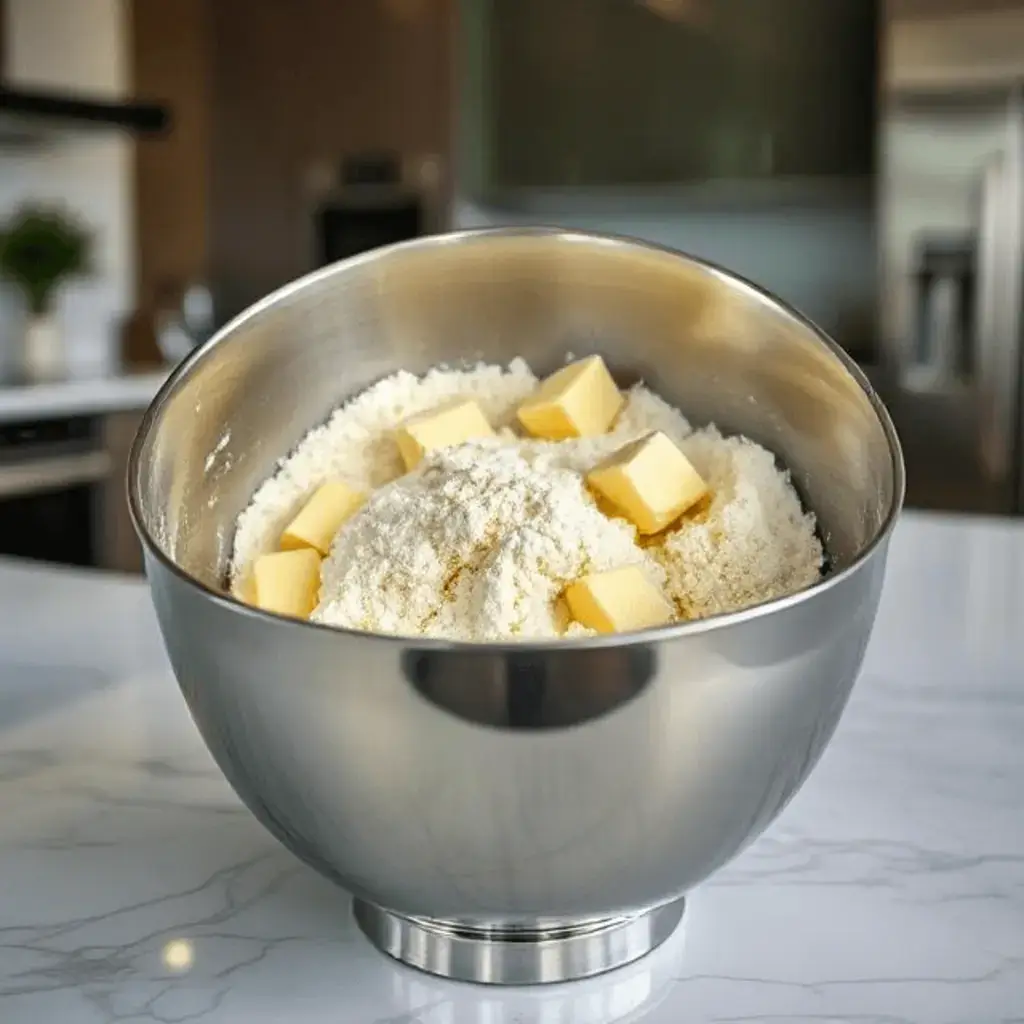
Mix the Dry Ingredients
In a large bowl, combine:




Cut in the Butter
The butter is what makes the crumble golden, crispy, and delicious.
- Use cold butter and cut it into small cubes.
- Rub it into the dry ingredients using your fingertips until the mixture resembles coarse breadcrumbs.
- Don’t overmix—you want some clumps for the perfect texture.
Customize Your Topping
To add variety to your crumble, try:
- Coconut flakes for a tropical twist.
- Chocolate chips for a dessert-like crumble.
- Orange or lemon zest for freshness.

3. Assembling the Crumble
Once your fruit and topping are ready, it’s time to assemble!
Layer the Fruit
- Spread the prepared fruit filling evenly in a buttered baking dish.
- Press it down lightly to create an even base.
Sprinkle the Crumble Topping
- Evenly distribute the crumbly mixture over the fruit.
- Don’t press it down too much—it should sit loosely on top for a crispier finish.
Add Extra Texture (Optional)
For an even crunchier crumble, sprinkle:



4. Baking the Crumble to Perfection
Baking is where all the flavors come together. The right temperature and time ensure a bubbling, juicy filling and a crispy, golden topping.
Set the Right Temperature
- Bake at 180°C (350°F) for most crumbles.
- If using very juicy fruits like berries, bake at 190°C (375°F) for a firmer filling.
Baking Time
- Small crumbles (individual servings): 25-30 minutes
- Medium-sized crumbles (8-inch dish): 35-40 minutes
- Large crumbles (9×13-inch dish): 45-50 minutes
How to Know When It’s Done




5. Serving and Storing Your Crumble
Now that your homemade crumble is baked to perfection, here’s how to serve and store it properly.
Best Ways to Serve Crumble
Crumble tastes amazing on its own, but these pairings make it even better:
- Vanilla ice cream – The warm and cold contrast is irresistible!
- Whipped cream – Light and airy, a perfect balance.
- Custard or caramel sauce – Adds extra creaminess.
How to Store Leftover Crumble
- Room Temperature: Keep for 1 day, loosely covered.
- Refrigerator: Store in an airtight container for up to 4 days.
- Freezer: Freeze unbaked crumble for up to 3 months.
Reheating Tips
- Oven: Warm at 160°C (320°F) for 10-15 minutes for best texture.
- Microwave: Quick option, but may soften the topping.

Final Thoughts on Making the Perfect Crumble
Now that you have a step-by-step guide, you’re ready to make the best crumble ever! Whether you choose a classic apple crumble, a berry-packed dessert, or a nutty, spiced twist, this foolproof method guarantees a crispy, golden topping and a juicy, flavorful filling every time.
In the next section, we’ll explore exciting crumble variations, including gluten-free, vegan, and unique ingredient swaps. Stay tuned!
Delicious Crumble Variations: Gluten-Free, Vegan & More
Crumble is a versatile dessert that can be easily adapted to different dietary needs and flavor preferences. Whether you want a gluten-free crumble, a vegan-friendly option, or a creative twist with unique ingredients, there’s a crumble for everyone!
In this section, we’ll explore exciting variations that keep the classic crumble delicious, crispy, and satisfying while making it accessible to all.
1. Gluten-Free Crumble
For those avoiding gluten, you can still enjoy a deliciously crisp and golden crumble by using alternative flours and binders.
Best Gluten-Free Flours for Crumble




How to Bind the Topping Without Gluten
Gluten helps create structure in a traditional crumble, so for a gluten-free version, try:
- Cornstarch or arrowroot powder to thicken the fruit filling.
- Chia seeds or flaxseeds for added binding in the topping.

2. Vegan Crumble (Dairy-Free & Egg-Free)
A traditional crumble uses butter for a rich, flaky topping, but it’s easy to make a vegan crumble that’s just as delicious!
Best Vegan Butter Substitutes



Natural Sweeteners for a Vegan Crumble
Instead of refined sugar, try:
- Maple syrup for a deep, caramel-like flavor.
- Coconut sugar for a subtle molasses taste.
- Agave syrup for a mild sweetness.

3. Low-Sugar & Healthy Crumble Options
If you’re looking for a healthier crumble without sacrificing flavor, consider reducing sugar and using nutrient-dense ingredients.
How to Reduce Sugar in Crumble



Healthy Topping Alternatives
- Oat & Nut Mix: Use ground almonds, oats, and flaxseeds instead of flour.
- Chia & Flaxseeds: Add fiber and omega-3s for extra nutrition.
- Greek Yogurt (for serving): A healthy, creamy alternative to ice cream.

4. Unique & Creative Crumble Flavors
Want to make a crumble that stands out? Try these exciting flavor twists to give your classic dessert a modern upgrade.
Chocolate Crumble
- Add cocoa powder to the crumble topping.
- Mix in dark chocolate chunks for a gooey surprise.
- Best with cherries, raspberries, or bananas.
Tropical Crumble
- Use coconut flakes and macadamia nuts in the topping.
- Best fruit pairings: Pineapple, mango, passion fruit, or banana.
Spiced Crumble (Perfect for Fall)
- Add ginger, cardamom, or cloves to the crumble topping.
- Pairs well with: Apple, pear, or pumpkin filling.

5. Savory Crumble (A Twist on the Classic Dessert)
Did you know crumbles can be savory too? By replacing sugar with cheese, herbs, and spices, you can create a delicious topping for meats or vegetables.
Best Savory Crumble Ideas



How to Make a Savory Crumble
- Use flour and oats as a base (same as a sweet crumble).
- Replace sugar with grated cheese, nuts, or breadcrumbs.
- Mix in melted butter or olive oil for a crispy finish.

Final Thoughts on Crumble Variations
No matter your dietary needs or flavor preferences, there’s a crumble for everyone! Whether you go for a gluten-free, vegan, or unique twist, these variations allow you to customize and enjoy your crumble in new ways.
In the next section, we’ll cover common crumble mistakes and troubleshooting tips to ensure your crumble always turns out golden, crispy, and delicious. Stay tuned!
Common Crumble Mistakes & How to Fix Them
Even the most experienced bakers can run into crumble mishaps—from a soggy topping to a dry, flavorless filling. If your crumble isn’t turning out as golden, crispy, and delicious as you’d like, don’t worry! This section will help you identify and fix common crumble problems to ensure perfect results every time.
1. Why Is My Crumble Topping Not Crispy?
A crispy crumble topping is one of the best parts of this dessert, but sometimes it turns out soft or doughy instead.
Possible Causes & Solutions





2. Why Is My Crumble Too Dry?
A crumble that turns out too dry and lacks rich, buttery crumbs can feel disappointing.
Possible Causes & Solutions





3. Why Is My Crumble Soggy or Watery?
A soggy crumble is usually caused by excess fruit juice making the topping wet instead of crisp.
Possible Causes & Solutions





4. Why Is My Fruit Filling Too Tart or Too Sweet?
The right balance of sweetness and tartness is key to a flavorful crumble.
Possible Causes & Solutions




5. Why Does My Crumble Topping Sink into the Fruit?
A good crumble should have a distinct fruit layer and a separate crispy topping—not a soggy mess!
Possible Causes & Solutions





6. Why Does My Crumble Burn on Top?
If your crumble burns before the fruit is fully cooked, you might need to adjust your baking method.
Possible Causes & Solutions





7. Why Doesn’t My Crumble Have Enough Flavor?
If your crumble tastes bland, it might need a boost of spices, acidity, or mix-ins.
Possible Causes & Solutions





Final Thoughts on Troubleshooting Crumbles
Mastering the perfect crumble takes a few tweaks, but with these tips, you’ll always get a golden, crispy topping and a flavorful fruit filling.
In the next section, we’ll answer frequently asked questions about crumbles, including storage tips, reheating tricks, and the best fruits for every season. Stay tuned!
Frequently Asked Questions About Crumbles
In this section, we’ll answer the most frequently asked questions about crumbles. From storing to freezing to the best fruit combinations, we have you covered with expert advice and tips for the perfect crumble every time!
1. Can I Make Crumble Ahead of Time?
Making crumble ahead of time can save you time and ensure you always have a delicious dessert ready to go. Here’s how to prep your crumble in advance:
How to Prepare Crumble in Advance
- Prepare the Topping & Filling Separately: Store the fruit filling and crumble topping separately for up to 24 hours in the fridge.
- Assemble and Refrigerate: You can also assemble the entire crumble and refrigerate it for up to 24 hours before baking.
- Freezing Crumble: If you want to store it for longer, freeze the unbaked crumble for up to 3 months and bake directly from frozen.

2. Can I Freeze a Crumble?
Freezing crumbles is a great way to make your dessert in advance or preserve leftovers. Learn how to freeze your crumble properly for the best results.
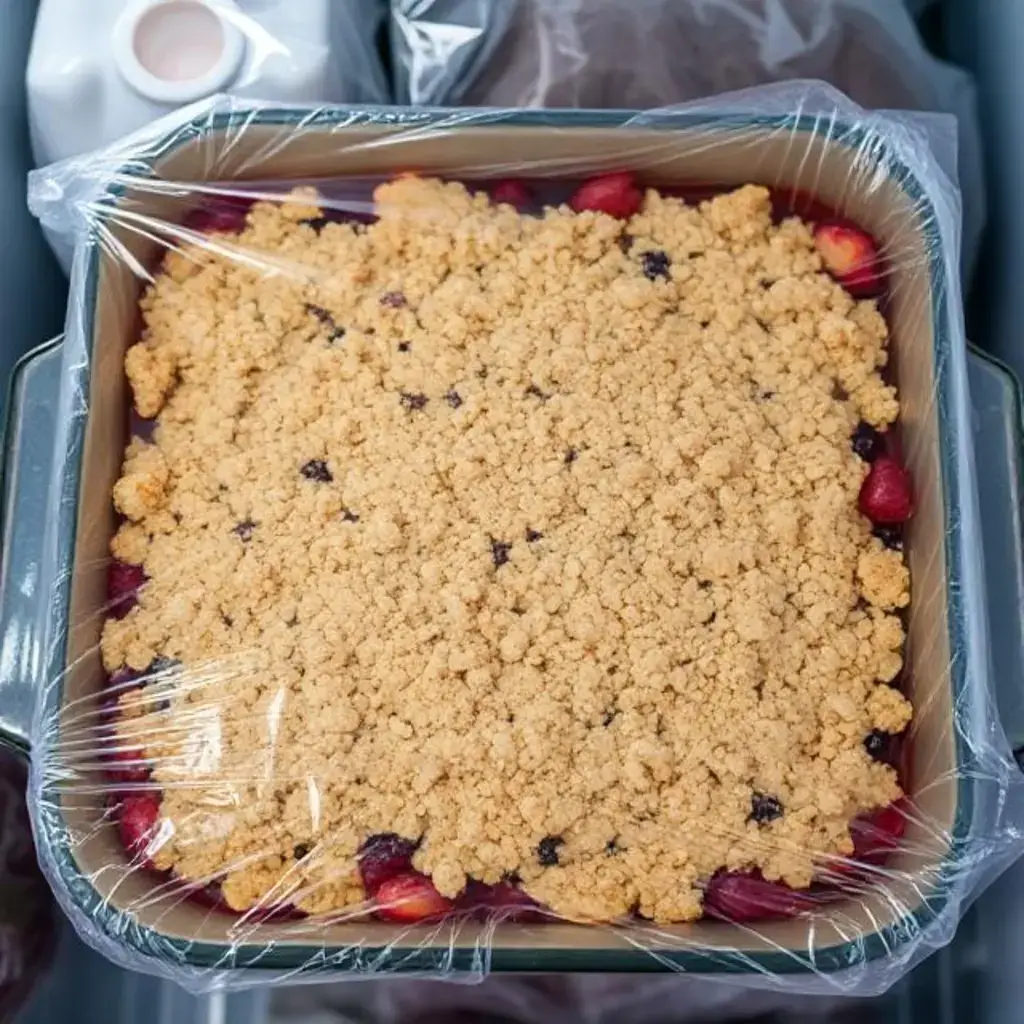
How to Freeze Crumble
- Unbaked Crumble: Assemble your crumble and freeze it in an airtight container for up to 3 months.
- Baked Crumble: If you have leftovers, freeze them in a tightly sealed container for up to 3 months.
- Reheating Frozen Crumble: For unbaked crumble, bake it straight from frozen at 180°C (350°F) for about 60 minutes. For baked crumble, reheat at 170°C (340°F) for 20-25 minutes.

3. What Are the Best Fruits for Crumble?
The right choice of fruits can make or break your crumble. Here’s a list of the best fruits that provide the right balance of texture and flavor.
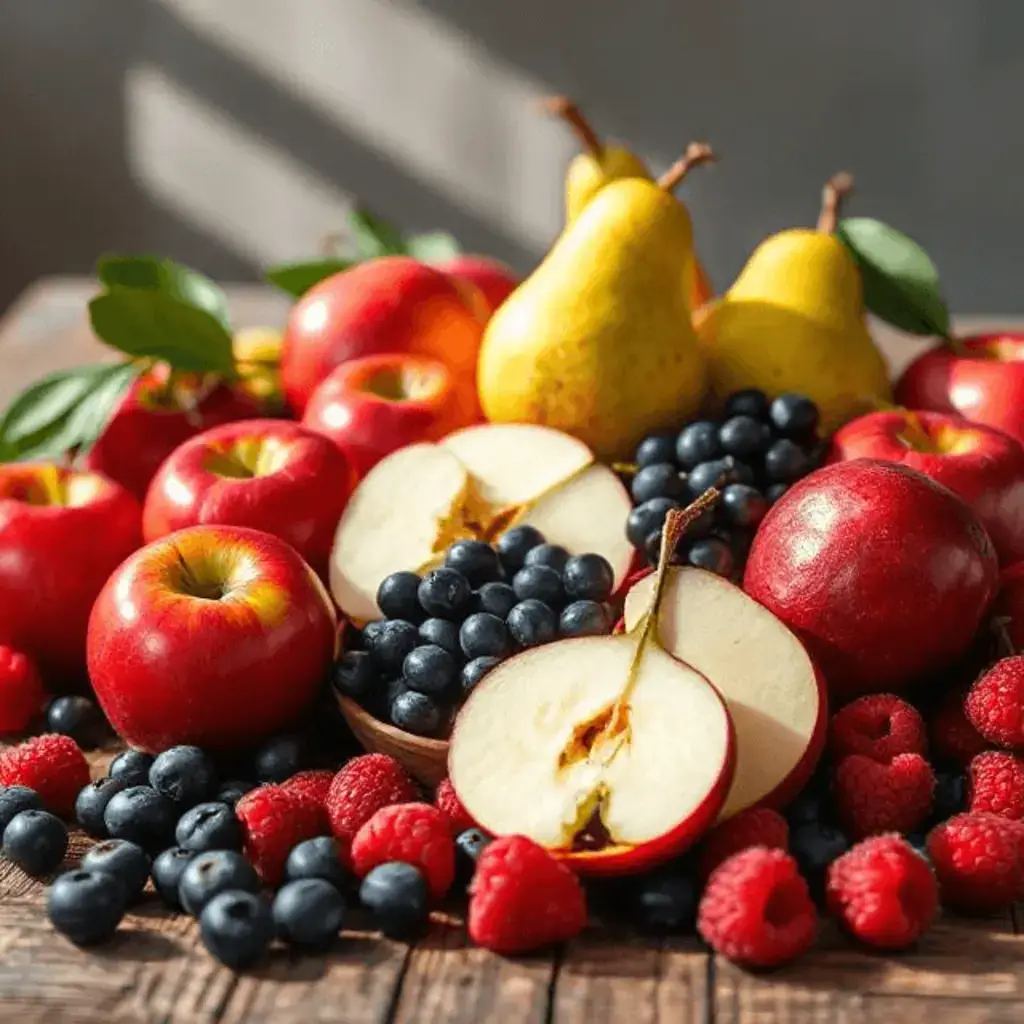
Top Fruits for Crumble
- Apples: A classic choice for crumble. Use firm varieties like Granny Smith or Honeycrisp.
- Berries: Blueberries, raspberries, strawberries, and blackberries add vibrant color and tartness.
- Pears: Bartlett and Anjou pears blend well with apples and add sweetness.
- Peaches & Plums: These juicy fruits work wonderfully for summer crumbles.
- Rhubarb: This tart fruit adds a refreshing bite when mixed with sweeter fruits like strawberries.

4. Can I Use Store-Bought Crumble Topping?
Store-bought crumble toppings can be a convenient shortcut, but they might not deliver the same flavor and texture as homemade. Here’s how to use them effectively:
Advantages of Store-Bought Topping
- Quick & Easy: Saves time when you’re in a rush.
- Consistent Texture: Pre-mixed toppings often provide a reliable, uniform texture.
Disadvantages of Store-Bought Topping
- Less Flavor: Store-bought toppings may lack the depth of flavor from homemade ingredients.
- Additives: Many commercial options contain preservatives and artificial flavors.

5. Can I Add Nuts to My Crumble?
Nuts can elevate the flavor and texture of your crumble, adding a delicious crunch. Here’s how to incorporate them:
Best Nuts for Crumble
- Walnuts: Rich and slightly bitter, walnuts add an earthy flavor.
- Almonds: Sliced or chopped almonds bring a delicate crunch.
- Pecans: Their buttery flavor makes them a great choice for crumbles.
- Hazelnuts: These nuts give a warm, toasted flavor and satisfying crunch.
How to Use Nuts in Crumble
- In the Topping: Add chopped nuts directly to the crumble topping mixture for extra texture.
- On Top: Sprinkle crushed nuts over the crumble before baking for a crunchy finish.

6. What’s the Difference Between Crumble and Crisp?
A common confusion is the difference between crumble and crisp. Let’s clarify:
Crumble vs. Crisp
- Crumble: This dessert has a buttery, flour-based topping that may or may not include oats or nuts.
- Crisp: Typically includes oats and/or nuts in the topping, which gives it a crunchier texture.

7. Can I Make a Crumble Without Sugar?
If you’re looking to reduce sugar, you can still enjoy a delicious crumble by using natural sweeteners or sugar alternatives.
Sugar Alternatives for Crumble
- Stevia: A natural, no-calorie sweetener.
- Monk Fruit or Erythritol: Low-carb sweeteners that mimic sugar.
- Maple Syrup or Honey: These add a natural, flavorful sweetness.
How to Make Sugar-Free Crumble
- Use naturally sweet fruits like bananas, pears, or peaches.
- Add spices like cinnamon and nutmeg to enhance the flavor without sugar.

Conclusion: Perfecting Your Crumble
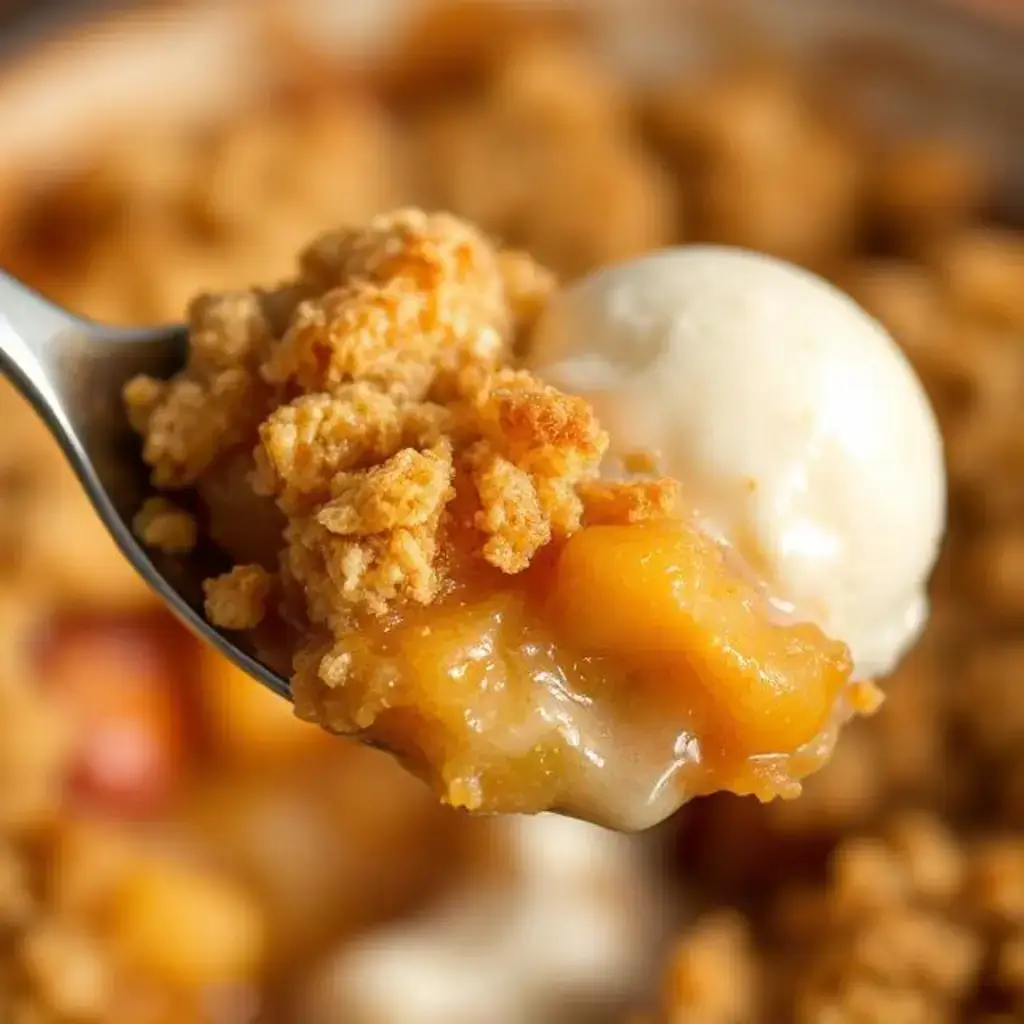
By now, you should have all the tips, tricks, and answers to make your perfect crumble every time! Whether you make it ahead of time, freeze it for later, or play around with fruits and nuts, you now have the knowledge to create a crumble that’s always delicious. Stay tuned for more crumble recipe ideas in our next post!
